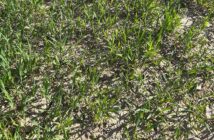Hutchinsons northern technical manager, Cam Murray, is reminding growers of the need for accurate OSR desiccation timing to maximise yield and minimise the risk of rejections, regardless of method.
Desiccating with glyphosate is generally the preferred approach for many crops, although mechanical swathing still has a place, particularly in very thick and/ or leaning crops, he notes. “It’s important not to go too early, as this can damage the seed filling process, reducing yield and increasing the chance of red seeds due to uneven ripening – anything more than 5% and growers will face rejection issues.”
Crop appearance and seed colour are the best guide to determining the optimum desiccation spray timing, and a good rule of thumb is to wait until the canopy is roughly the colour of a hare, Cam adds.
When inspecting seed colour, he says to always take samples from the main raceme (flower cluster on the main stem), as this will ripen first.
“If, out of 20 sample pods, two-thirds have changed from green to brown, then this is the early desiccation timing, and from this stage, I’d suggest applying glyphosate in the next four to seven days and remember the need to follow glyphosate best practice guidance.”
Pod sealants can be a useful addition to reduce the risks of pod shatter in the event of harvest being delayed due to the weather, or where growers have to wait to combine crops due to variable maturity, especially on more exposed sites, Cam adds.
“Generally, the optimum timing is before glyphosate is applied, although more generally, pod sealants are applied as part of a tank mix.”
Alternative approaches
Although mechanical swathing is not the most popular option, Cam says it can still be very effective for leaning crops and those with thick stems. It may also be an option on seed crops, where pre-harvest glyphosate cannot be used.
AHDB guidance says crops can be swathed around six weeks after the end of flowering, when seeds in the top third are green and green/brown, those in the middle third are green/brown, and those in the bottom third are dark brown/black.
When swathing, he reminds growers of the need to leave a good stubble height (20–30 cm) to keep the swathed crop off the ground and aid air flow.
In some situations, growers may choose to allow crops to ripen naturally and combine directly.
“This can be an option for weed-free and very uniform crops, and is useful for those who have large areas and are trying to spread the harvest window. But remember, the crop will take longer to ripen.”




